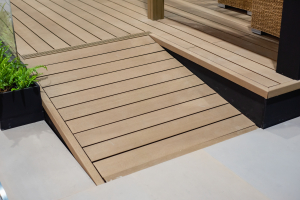Implementing environmental controls to prevent slips

Last Updated on October 6, 2025 by admin
Owning a holiday home or holiday let comes with a number of considerations. One of the primary ones is how to keep your guests and yourself safe in and around your property. Included in this is the risk of slips and trips. The two main environmental factors that can lead to slips are weather conditions and lighting levels.
Weather conditions
Rain, wind, frost, and snow can affect underfoot conditions both indoors and outdoors. During autumn and winter there is less daylight, leaves fall on to wet paths making walkways slippery, and cold weather spells can lead to ice and snow build up along paths and patios. The effective management of buildings, footpaths, car parks and grounds during bad weather has a significant impact on mitigating the risk of slips.
Drainage and canopies for wet weather
Implement suitable precautions at building entrances to prevent walk-in contaminants (e.g. water). Canopies shield doorways from direct rainfall, keeping access points drier and safer. Meanwhile, well-designed drainage systems, such as sloped paving, gutters, and channels, can divert excess water away from paths and doorways, preventing puddles and slip hazards.
To discuss Home Insurance for your holiday home, cottage complex, or second home, contact us today.
Call: 01237 429 444
Request a Quote: boshers.co.uk/get-your-quote/

Managing slopes and ramps safely
Managing slopes and ramps safely in a holiday let is about combining good design with practical upkeep. Surfaces should be non-slip, well-drained, and free from obstructions to reduce fall risks. Gradients should be gentle, ideally 1:20 or less, with sturdy handrails for support.1 The width of a ramp (e.g. for wheelchair access) should be at least 900mm.2
Ramps and slopes should be regularly inspected for wear, moss, or debris, and maintained promptly. Clear signage can be used to guide guests, particularly those with limited mobility.
How to reduce rainwater carry-in at cottage entrances
Installing a sheltered porch or canopy provides the first line of defence, limiting direct rainfall at the doorway. Using raised decking or sloped paving ensures water drains away from the entrance rather than pooling. Regularly maintaining gutters and downpipes also prevents overflow onto pathways.

Making outdoor decking safer
Outdoor decking anti-slip treatments improve safety by adding a textured, slip-resistant finish to timber or composite surfaces. Options include clear coatings, paints with grit additives, or specialist oils. These treatments enhance grip in wet conditions, are long-lasting, and preserve the natural look of decking while reducing accident risks.
Entrance matting systems
Entrance matting systems are designed to trap dirt, moisture, and debris at entry points, protecting internal flooring and reducing slip hazards. They typically combine coarse mats outside to remove grit and absorbent mats inside to capture moisture. You can buy specialist entrance matting systems made from heavy-duty or natural and sustainable materials.
Be prepared!
Implement suitable procedures to make access routes which are affected by ice, frost or snow safe. This will include:
- Identifying the outdoor areas used by pedestrians that are most likely to be affected
- Monitoring the temperature and weather forecasts to identify when adverse weather may affect access routes
- Gritting areas prone to be slippery in frosty or icy conditions
- Diverting pedestrians to less slippery walkways and cordoning off those that are unsafe
- Keeping staff and visitors informed of which car parks and access routes are open
Gritting
The most common method used to de-ice floors is gritting as it is relatively cheap, quick to apply and easy to spread. Rock salt (plain and treated) is the most commonly used ‘grit’. It is the substance used on public roads by the highways authority.
Gritting should be carried out when frost, ice or snow is forecast or when walkways are likely to be damp or wet and the floor temperatures are at or below freezing. The best times are early in evening before the frost settles and/or early in the morning before employees arrive. Salt doesn’t work instantly; it needs sufficient time to dissolve into the moisture on the floor.
If you grit when it is raining heavily the salt will be washed away, causing a problem if the rain then turns to snow. Compacted snow, which turns to ice, is difficult to treat effectively with grit. Be aware that ‘dawn frost’ can occur on dry surfaces, when early morning dew forms and freezes on impact with the cold surface. It can be difficult to predict when or where this condition will occur.
Keeping areas clean and clear
Remove wet and decaying leaves, moss and algae at regular intervals as these can create slip risks in two ways: they can hide any hazard that may be on the path or they themselves present a slip risk.

Lighting
The Health and Safety Executive has a downloadable pdf that sets out the standards required for ensuring safe and adequate lighting. Although it is called “Lighting at work” it can apply to holiday let owners who may employ people and who have paying or non-paying guests stay at their property.
The directive provides advice on the amount of light required for different areas or activities and the need to avoid lighting that creates glare or shadows. It also provides guidance on lighting areas where hazards are present and how to make them sufficiently visible.
By taking steps to light your holiday let in the correct way, you can mitigate the risks of guests slipping or tripping on hazards such as uneven steps or wet pathways. In turn, this can reduce the necessity of making an insurance claim and go towards standing in good stead with your insurer.
Lighting lux levels to reduce trip risk
Indoor areas including entrance halls and lobbies, and corridors and stairs need around 100-200 lux as a baseline, and 500 lux for kitchens.3
Residential paths need to be lit to lux levels of 100-150, and driveways or areas with higher foot traffic to 150-200 lux. If there are areas in your garden where you would like to create a softer ambience, and safety isn’t as important (i.e. the area is not used as much) you can go for 50-100 lux.4 Motion-activated lighting for seldom-used but risky areas, can light the way so that people aren’t left in the dark suddenly.
Regularly measure lighting with a lux meter. Bulbs degrade over time and dirt on fittings can reduce effective lux levels.
If you would like a new quote for your holiday let, or if you would like to discuss your existing policy with our team of helpful experts, get in touch.
To discuss Home Insurance for your holiday home, cottage complex, overseas property, or second home, contact us today.
Call: 01237 429 444
Request a Quote: boshers.co.uk/get-your-quote/
This guidance is provided for information purposes and is general and educational in nature. It should not be used as a substitute for taking professional advice on specific issues and should not be taken as providing legal advice on any of the topics addressed.
1-2: https://www.barriersdirect.co.uk/blog-posts/183-wheelchair-ramps-uk-regulations-guidelines
3-4: https://www.luxgeneral-lighting.co.uk/recommended-lighting-levels/




